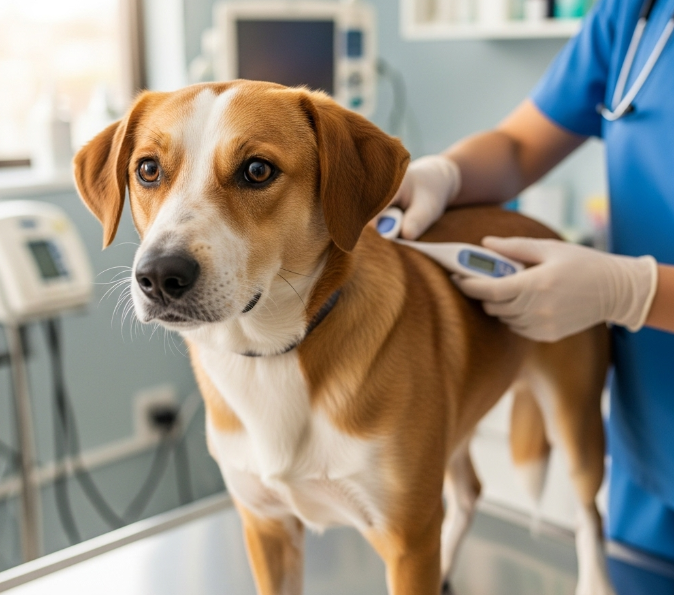Recognize signs of unusual temperature changes and know when to consult a vet.

You might be surprised to learn that dogs naturally run warmer than humans. Their normal internal body temperature is higher, which is why your furry friend often feels so warm and cozy, especially on chilly nights!
Understanding your dog’s normal temperature and knowing how to check it can help you spot health problems early. Here’s a straightforward guide to what’s normal, when to worry, and how to safely take your dog’s temperature at home.
What Is a Dog’s Normal Body Temperature?
A healthy dog’s normal body temperature typically ranges from 100.5°F to 102.5°F—about 101.5°F on average. If your dog’s temperature goes above or below this range, it’s time to contact your veterinarian.
Emergency alert:
- Temperatures above 104°F or below 99°F are dangerous and require immediate veterinary attention.
- Extremely high or low temperatures can be life-threatening if not treated quickly.
What To Do If Your Dog’s Temperature Is Abnormal
If your dog’s temperature is dangerously high or low, head to the nearest open vet clinic right away. If you can, call ahead to get advice on what to do while en route. Avoid giving any medications at home without your vet’s approval.
Important: Never give dogs human painkillers like acetaminophen or ibuprofen—these are toxic to dogs and can cause severe harm.
How to Help Your Dog Before You Get to the Vet
If Your Dog Is Too Cold (Hypothermia):
- Use warm (not hot) water bottles or a heating pad on the lowest setting.
- Always place a blanket or towel between your dog and the heat source to avoid burns.
- Let your dog move away if they get too warm.
- Never leave your dog unattended while warming them.
If Your Dog Is Too Hot (Hyperthermia):
- Offer cool (not cold) water for drinking, but don’t force it.
- Apply cool, damp towels to their neck, armpits, and groin. Remove towels regularly to let air circulate.
- Avoid ice or very cold water—it can cause blood vessels to constrict and worsen overheating or even cause hypothermia.
Remember, these are temporary measures. Your dog still needs to see a veterinarian to treat the underlying cause.
How to Take Your Dog’s Temperature Safely at Home
Checking your dog’s temperature is a key part of first aid. The most accurate method is rectal, but here’s what you need to know:
What You’ll Need:
- A digital rectal thermometer
- Water-based lubricant (like KY Jelly) or baby oil
- A helper to gently hold your dog, if possible
Steps:
- Don’t try to take an oral temperature—it’s unsafe and inaccurate for dogs.
- Have your helper gently hold your dog still and calm.
- Apply lubricant to the thermometer tip.
- Lift your dog’s tail and gently insert the thermometer about 1 inch into the rectum.
- Wait for the beep, then carefully remove and read the thermometer.
Having Trouble With Rectal Temps?
You can get an approximate reading by placing the thermometer under your dog’s front leg (in the armpit), holding their leg snugly against their body. Add 1°F to this reading to estimate their body temperature. Keep in mind, this method isn’t as accurate—visit your vet if you’re unsure.
Extra Tips for Taking Your Dog’s Temperature
- Use a thermometer dedicated only to pets and label it clearly.
- Ignore “fever alerts” designed for humans since dogs naturally have higher temperatures.
- Avoid glass thermometers—they’re unsafe if broken and take longer to read.
- Flexible thermometers can be more comfortable but might be harder to insert.
- Ear thermometers for dogs exist but aren’t very accurate.
- Don’t judge your dog’s temperature by how warm their nose or body feels—this is a common myth.
Stay Calm and Act Quickly
If your dog’s temperature is abnormal, try to stay calm. Dogs can sense your stress, which may worsen their condition. Take a few deep breaths, safely take their temperature, and get your dog to a vet as soon as possible.
If you think your dog is sick or notice any unusual behavior, contact your veterinarian immediately. They know your pet’s history and can guide you best on how to help your furry friend.
